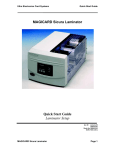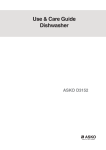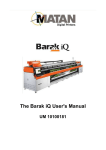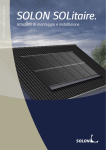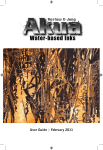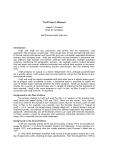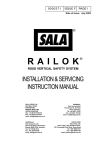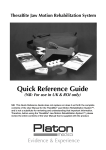Download INSTALLER HANDBOOK
Transcript
INSTALLER HANDBOOK Arlon’s Recommended Installation Techniques Technical Service July 2008 INSTALLER HANDBOOK Table of Contents Subject Page Storage and Shipment of Vinyl 3 Installation Tools 3 Selection of Application Paper 4 Sign Substrates Substrate Preparation Installation Considerations for Special Substrates 5-6 Application Procedures Overlaps Corrugated Sections Cold Weather Installation 7-9 Thermoforming Steps 10-12 Removal of Film and Adhesive 13-14 Special Cases 87V/DPF8000 Usage and Application of 4560GT and 4560GTX Metallized Polyester and Reflective Film 15-16 2 STORAGE OF ARLON® VINYL Vinyl on Rolls: Vinyl product stored at controlled conditions will remain flexible and retain high tack for at least a year after purchase. Arlon’s factory warehouse is kept cool and dry to preserve vinyl product on the shelf. No matter what storage conditions are used it is important to consume materials promptly, avoid mixing old and new lots, protect film from excessive ambient moisture and ensure roll edges remain flat and unwrinkled. If product is certain to be on the shelf for an extended period store it in the coolest part of the facility and control relative humidity near 50%. Storage position and location in the warehouse or rack is important as well. As most vinyl materials are laminated to paper based release liner care must be taken to keep them from direct contact with concrete floors or unsealed, exterior concrete or masonry walls. If rolls are stored out of their protective box, it is important to store them upright with space between rolls. This prevents the development of mottling (dulling) at points of contact with either the floor or adjacent rolls. If excessive direct moisture contact occurs with any graphic film, the following damage may follow: • The liner will expand at the location of moisture contact, causing surface mottling. • The silicone release coating on the liner will become inconsistent and cause difficult character weeding. • The paper will tend to curl or become “wavy” when it is unwound. Curled product edges make automatic sheet feeding, screen printing, die cutting, weeding, overlaying with application tape and back slitting and very difficult. Finished Graphics: Store cut and masked graphics flat, in a clean, dry, cool place. Never subject fabricated graphics to moisture, excessive humidity, direct sunlight or temperatures above 100°F (38°C). Finished graphics should be stored flat when possible, to prevent the layers from separating and creating wrinkles in the finished product. If rolling is needed for transport then loosely roll with the graphics facing outward and liner inward. Vinyl Graphics with 3320 Antigraffiti Overlaminate: Store and ship any graphics produced on flexible fabric with the semirigid Arlon #3320 overlaminate as the protective film on cores greater than 5 inches at inside diameter with the Arlon #3320 facing outward. Tighter winding of these graphics will result in eventual tunneling and lifting away of the overlaminate and base film. Should the #3320 tunnel it will resist efforts to flatten during installation and tensioning. INSTALLATION TOOLS Before starting an installation it is best to have the appropriate tools handy to avoid interruptions during the application. Starting and stopping midway through sign fabrication can be costly due to inadvertent material damage and loss. • Plastic Squeegee (nylon with uniform edge • Utility or craft knife • Felt or Felt wrapped squeegee • 1.5 inch (3.8 cm) rolls of masking tape • Low friction sleeves for squeegees • Marking pencils • Lint-free rags • Spray bottle of Isopropyl alcohol and water @ 1:1 • • Heat gun or propane torch Rivet Brush (1 inch / 3 inch) • Air release tool (punch wheel or needle) 3 SELECTION OF APPLICATION PAPER Once vinyl is die cut and weeded, application paper (also called transfer tape, premask or prespacing tape) is applied over the remaining film. This application paper serves many purposes. First, it protects the surface of the vinyl from damage during storage and installation. Secondly, it serves as a stable medium with which to transfer very flexible, easily distorted vinyl from the liner paper to the substrate. Application Tape is most popularly made of thin paper tissue for both cost and performance reasons. • Paper has some obvious advantages in that it is compatible with many stages of sign fabrication. One can write on it easily for registration marks and it is more compatible with wet application techniques than film based types due to the papers ability to absorb and transmit water to the graphic face. This is needed to reduce adhesion between the vinyl film and application tape, making it easier to strip the application tape away from the applied graphics. • Plastic film as transfer tape proves its greatest advantage when registration of multicolor overlays is needed. A weakness of plastic film is that it doesn’t have water absorption capability so does not work well for wet applications. In the mid-nineties clear plastic film gained in popularity as cost was reduced, lamination performance improved and finishing steps in the manufacturing process allowed the plastic to be torn cleanly from the roll rather than requiring a knife or scissors cut. Proper lamination of application paper or film is a relatively simple procedure. Although this seems to be a minor step in the production process, adherence to a few basic rules can help avoid major installation disasters. 1. Take the time to select the right application paper for your shop. This will require some simple comparative tests. For example, application paper comes with either low, medium or high tack adhesive. Choose a tape that bonds sufficiently to lift the graphics off the liner paper. After the graphics are applied, the application paper should remove easily without tearing. In short, select an application paper that is easy to use over a wide range of films and substrates. 2. Use a single sheet of application tape to cover a vinyl graphic rather than trying to get by with overlapped pieces of tape. Overlapped application tape results in a line of small bubbles at the overlap during final installation. 3. Take care in applying application tape to a vinyl graphic. Wrinkles and bubbles caught in the application tape result in wrinkles and bubbles in the installed vinyl. Also, avoid stretching the application paper, this helps prevent poor graphic registration and wrinkles and curl. When removing graphics from liner lift away slowly, be sure that the tips and leading edges of the graphic film do not remain with the liner. If the vinyl has trouble separating from the liner a method for easier removal is to turn the graphic upside down (so the graphics are face down) and strip the liner away from the graphic on the workbench. 4 SUBSTRATE PREPARATION Before installing any graphics a clean substrate is critical. Although many cleaners will do an adequate job, some outperform others for specific applications. Based on our experience, recommendations for final cleaning are the following: Substrate Painted metals & wood Cleaner Isopropyl Alcohol a.k.a. 70% Rubbing Alcohol @ 1 to 1 mix with water. Large Panels on Vehicles Degreaser, if needed, then IPA and water mix to finish. See Riveted Application for details. Cautionary Note: It is common to think that a strong solvent will be the best cleaner for banner and other surfaces that are hard to stick film to. In the case of many plastics and paints this is wrong. Cleaning with a strong solvent such as MEK and acetone or paint thinner can lead to premature sign failure via embrittlement, cracking and crazing or loss of gloss. • Use the mildest solvents possible - only clean until the surface dirt is gone. 1. A quick test for plastics - a sample of the substrate with applied vinyl is placed in an oven at 150°F (78°C) for as long as 24 hours or in the sun on a vehicle for a couple of days. If bubbling occurs during the test, it will likely occur in the sign. Polycarbonate sheets absorb and outgas moisture. These materials should be dried prior to and after vinyl application. (Consult the polycarbonate manufacturer’s recommendations for drying). Vinyl applied over undried polycarbonate can trap outgassing moisture, resulting in bubbles. All vinyl breathes to some extent allowing a certain amount of outgassing to dissipate after after a few heat/cold cycles at the intended application site. Overlaminate #3320 is not vinyl and will not allow any outgassing to dissipate when installed over incompletely dried substrates: fresh prints, fresh paint, saturated polycarbonate etc. (See Thermoforming Section for more detail regarding polycarbonate, beginning on pg. 13.) 2. Banner Applications – One can choose many banner substrates that are designed for paint and vinyl receptivity. However, there are also a number of products that are unsuitable. If you have a question regarding a sign substrate, do not hesitate to ask your Calon® distributor or call Arlon direct. Banner compatibility has been tested for the many U.S. and many internationally produced banners. For non-vinyl receptive banners, primer coats will aid vinyl adhesion and act as a plasticizer barrier. These coatings must be applied properly in order to achieve success. As a general rule, first clean the banner with either a mild solvent such as IPA. Never use lacquer thinner or harsh solvents they will draw the banner’s plasticizer to the surface, adversely affecting the prep coat and ultimately the vinyl adhesion. After cleaning, coat the banner and allow it to dry at least 24 hours prior to vinyl application. Vinyl installation on banner is easy if you remember that these materials are essentially “textured” surfaces. The following techniques will ensure a quality finished product: • When applying pressure during lamination it is important to achieve good contact regardless of whether wet or dry application is used. A rivet brush or soft squeegee is recommended for attaining the best surface conformability. This is especially important with vinyl-impregnated fabrics that have rough texture. • Using heat with the rivet brush or soft squeegee increases conformability of the vinyl to “textured” surfaces. Heat softens the adhesive, making it more pliable and a bit tackier. Heat also melts the film slightly, reducing memory and allowing the vinyl to conform more readily to the new shape. The warmed vinyl “sets” in its new shape as it cools and thus exerts less delaminating force on the bond. 5 3. Coated Fiberglass – Fresh molded and gel-coated fiberglass typically retains a waxy film caused by the mold release agent used in the manufacturing process. This waxy film must be removed with an appropriate mold release solvent before graphics installation. 4. Varnish – Arlon does not recommend a varnish coat to be applied to vinyl graphics. Varnishes contain solvents that will attack the vinyl facestock and the adhesive system. Varnished graphics will typically peel away from the sign substrate. If an overcoat is demanded use acrylic, water-based types where possible. 5. Application Fluid – Application of pressure-sensitive material to flexible signface material, plastic sign faces and glass often requires the use of application fluid. Use the least amount of fluid needed to achieve repositionability. Be absolutely sure that all the wetting agent is removed from between the vinyl and the signage substrate. If any application fluid remains, bubbling will likely occur later. Also, be sure to allow enough time for good adhesion to build before removing the application tape. 3 tsp (3 ml) clear, liquid detergent 1 gallon (4.54 litre) water 3 tsp (3 ml) IPA Application Fluid may be modified with more and less alcohol to speed or retard subsequent drying time and thus adhesive bond. Using as much as 10% IPA in the mix will all for initial wet installation but will give the advantage of drying rapidly – thus allowing the removal of masking and subsequent trimming or additional overlaminating with other color. NOTE: Not all application fluids (even commercial brands) result in optimal adhesive bond. The user assumes the responsibility to test all application fluids prior to installation to ensure successful film performance. 6. Paints – All paints should be dried and cured before installation of signage. When painting sign faces to be decorated with film, use two lighter coats rather than one heavier; drying and curing will be faster and more complete. Low gloss and latex paints are harder to stick vinyl to than others. Although wiped with alcohol before installing graphics, a latex surface may still be incompatible with pressure sensitive graphics; therefore, the surface will have to be primed before installation. Arlon has tested and recommends Sherwin-Williams 600-6241 and ICI LM 9116. All gelcoats and urethane paints require cure time before vinyl may be applied. The curing period varies depending on product type, temperature, humidity and amount of catalyst or hardener. During curing, the paint or gelcoat will outgas. This outgassing must be completed prior to vinyl application or bubbling can occur. 7. Windows – If designing for large plate glass applications which experience high sun exposure, be sure to avoid large areas of very dark color next to a very light and reflective color. The difference in heat gain and glass expansion under extreme gray scale differences will cause fatigue and early failure of the glass. It is best to break up the design and use hue, rather than gray scale to achieve contrasting sign elements. For glass and many other smooth substrates when the sign face temperature reaches over 100°F (37°C) the tack of the adhesive can become unmanageable, especially if repositioning is going to be required. Before beginning an application on hot surfaces a clean water mist will achieve "evaporative cooling" on sign faces. This technique can bring the temperature down 5 to 25 degrees depending on the starting surface temperature, relative humidity and amount of water used. 8. Application Temperature – Though recommended application temperature varies from product to product, optimum application temperature range on the substrate is typically between 60°F (16°C) and 90°F (32°C). Successful installation can be accomplished at temperatures as low as 40°F (5°C) and as high as 120°F (49°C). At these temperature extremes, one can expect additional difficulty. 6 APPLICATION PROCEDURES Rule of Thumb: Only lay down and make substrate contact with the area of film to which you can apply high-squeegee pressure. While squeegeeing work from the center, outwards, toward the edge and from the top, down, in overlapping strokes. Air is easily trapped between the surface of the adhesive and sign. A sign installer who squeegees toward the nearest edge will find that the possibility of air entrapment is minimized. Wet Application Method: 1. Position the vinyl with the film face down against a clean surface. Starting at a corner, remove the liner. If the liner is a standard kraft type, do not get it wet prior to removal; the coatings on the paper could split off causing unsightly adhesive contamination. Plastic liners are unaffected. 2. Spray application fluid on both the adhesive side of the film and the sign substrate. 3. Position the film (sticky side down) on the sign substrate. Initially use light strokes squeegeeing the film into position. Starting at the center of the marking, re-squeegee the film using firm strokes. Firm strokes and a stiff squeegee will force the application fluid from underneath the film. 4. After application, spray the paper application tape with application fluid; allow to soak into application paper and remove after no more than 30 seconds. Remove the application tape by pulling it 180° against itself. This step prevents the formation of small bubbles that can develop during application tape removal. Re-squeegee all edges after application tape removal to ensure good adhesion and prevent edge lifting. A rivet brush may also be used in this part of the installation sequence to achieve a good film/substrate bond on textured surfaces. 5. To eliminate air bubbles or trapped application fluid puncture the bubble at one end and press it flat with a thumb or rivet brush starting at the other end. Large blister sized bubbles will need to be popped in the center and flattened from either edge towards the middle. (Always use a pin; never use a knife. A round pinhole will close around itself while a knife cut will open up over time.) NOTES: Vinyl film may be applied to flexible sign face material either prior to, or, after tensioning. In either case, apply adequate squeegee pressure to achieve maximum ultimate adhesion. If application tape is not used, spray the film face with application fluid to facilitate the squeegeeing procedure. It is advisable, in these instances, to use a low friction sleeve on the squeegee to prevent scratches on the film. Low friction sleeves are available through sign supply distributors. In this latter technique, it is recommended application be performed prior to installation 7 Overlaps: A Common Method Joined sections of film should overlap at least 1/16 – preferably 1/8””. 1. To create a uniform overlap, first tape a cutting strip onto the substrate. A two-inch (5 cm) piece of thin steel at 1/16th inch (1.6 mm) thickness is a good dimension for a cutting strip. 2. Lay both pieces of vinyl over the cutting strip. 3. Place a metal straight edge where the two pieces of film cover the cutting strip. With a sharp utility knife, cut through all layers of film. 4. Remove the straight edge, excess film and the cutting strip. 5. Complete the squeegeeing procedure to create a proper overlap with uniform and straight edges. Textured Surfaces: Certain Cast and Calendared film may be applied to heavily textured surfaces. These include architectural panels, banner material with a dense scrim, and masonry block. For substrates such as masonry block, trouble-free installations begin with good surface preparation. Masonry is porous and absorbs moisture as well as releases dust from its surface, which adversely affect adhesion. To avoid failures the substrate must be sealed. Non-latex masonry paint will generally serve this purpose. As always, before vinyl can be applied to a painted surface, the paint must be completely cured. Some banner materials are not vinyl receptive and must be primed prior to film application. Commercial primer is available from sign supply distributors. Never clean the banner with a strong solvent such as lacquer thinner to get it to accept vinyl or screenprinting. Strong solvents will draw the plasticizers to the surface, making the prime coat ineffective and potentially contaminating the adhesive. 1. Begin the application to a textured surface by first squeegeeing graphics into position. 2. Remove the application tape from the graphic. Starting at one edge of the graphic, heat the vinyl with your heat gun. Burnish the vinyl with a rivet brush, using a circular motion to work the film into the texture. The finished product should look as if the graphic had been painted. 3. To avoid potential lifting and peeling at the edges for masonry applications, seal the edges with a commercial edge sealer. 8 Riveted and Corrugated Trailers: General Installations: Install vinyl after registering the lowest rearward panel (if a series of panels are to be applied) so that all panels afterward overlap to shed oncoming wind and dripping water. Starting from the top of each element squeegee from the center outward with each stroke overlapping the last in the downward direction. The vinyl should be draped up and over each corrugation rather than stretched from ridge to ridge then pressed into the valleys. Vinyl installed by exaggerated stretching will inevitably pop back off the surface and the graphic will quickly fail. Complete each corrugation row before moving to the next in order to retain proper material registration along the direction of the corrugations. • Sweep over rivet heads with the squeegee at a low angle while applying. Make sure the squeegee covers the entire head of the rivet or wrinkles will develop at the edge of the rivet. • Once all film is applied, any sections that cover a seam in trailer panels or other metal to metal joins must be slit and separately tucked into the seam. • Minor air bubbles are then worked out or popped with a pinhead, dart or other pointed tool. At this point the rivets will be covered with a loose dome of application paper laminated to vinyl and must be fixed securely to the whole surface of the rivet and surrounding panel. • Remove application paper by slowly pulling away from graphics at a low angle. • Punch holes (3 to 5) around the rivet heat with a pointed tool. • Press vinyl in place at ambient temperature with a rivet brush. • Secure the vinyl around the rivet with heat 300°F (150°C) and rivet brush using a circular motion. • Be sure the film is secure around all rivet heads and all panel to panel seams. Cold Weather Installation: The optimal installation range of a substrate is between 60° and 90°F (15° and 32°C). Substrate temperature may drop as low as 39°F or rise as high as 118°F (4° to 48°C) but expect more difficulty at the extremes. • Commercial shipping units such as piggyback containers and over the road trailers should be cleaned at least a day ahead of installation time. • To quickly warm trailers in cold environments, use portable blower type heaters to heat the inside of unit. Fifteen minutes of warm temperatures inside the trailers will help reduce the massive heat sink that has developed both inside the trailer and on the aluminum skin while sitting in a truck staging lot. To expedite heating in a warmed shop, open all trailer doors. Cold Weather Finishing Steps for Series 6000: Due to the repositionable nature of the ProFleet™ 6000 adhesive, the bond between substrate and graphic builds slower than with standard high tack “sign-vinyl.” While repositionability is a great advantage during installation, in cold weather it relies on proper technique during the final steps to maintain the bond created during earlier installation steps. Key points to remember when finishing cold weather installations: • The installer must be careful not to strip application paper before strong squeegee pressure has been applied. • If installing in cold environments use a heat gun or propane torch to soften the adhesive while using a squeegee. This ensures faster and more complete contact – doubling the adhesion bond. • Let as much time as possible elapse before removing application tape - up to three or four hours. • Remove application tape from the center of the graphics, working toward outer edges to avoid lifting. Pull the application tape parallel to the surface of the graphic. Remove tape in a smooth, slow manner rather than quickly or forcefully. • Go over the graphic with a heat source and squeegee or rivet brush after removing application tape. This ensures that all segments of the graphic during the application tape removal form a secure bond. 9 THERMOFORMING OF TRANSLUCENT FILM: SERIES 2500 Whether thermoforming prelaminated vinyl/plastic sheeting into simple pan faces or raised letters each aspect of fabrication: from material dehydration and lamination to releasing the formed piece is critical to the success of the finished sign. For successful thermoforming, the following factors must be considered: • • • • • Drying of sheet before and after lamination of film Lamination step Temperature of sheets and molds Rate of application and level of vacuum Sharpness of corners and edges 1. Pre-dry: Remove protective masking from the surface which is to receive vinyl and predry all acrylic and polycarbonate sheets prior to lamination of film. Predrying prevents bubbling during the forming cycle. Predrying is more critical to forming success when working with vinyl laminated plastic sheet than with sheet alone – especially for polycarbonate signfaces. Preferred method: Oven drying of suspended and separated sheets at approximately 200°F (93°C) for six hours. The simplest method is to load the drying ovens at the end of the workday for the following days fabrication. This allows the use of lower temperatures, down to 180°F (82°C) and more than enough time for adequate ventilation. For example, 6 hrs @ 200° F is minimum drying time for .080 in. thickness, according to a major polycarbonate fabrication guideline. Alternate method: (adequate for thin gauge acrylic sheeting) 1.2 Quick dry suspended and separated sheets at 230°F (109°C) for 30 minutes. 1.3 Slow dry sheets by removing masking and putting in a warm/dry area of the shop for 24 hours. Note: Once the sheet has been dried it should be further processed within 12 hours of being removed from dryer. 2. Lamination: Although lamination may be wet or dry, wet lamination can lead to problems with bubbles and cracking of film if all the surface water is not squeegeed away and dried before heating and forming. 2.1 Dry Application: When applying full sheets of uncut film with a mechanical laminator use the highest practical laminating pressure at throughput speed of about 30’/min. (10m/min). • Vinyl is best applied as free film immediately after being stripped away from the release liner. The point of stripping should be where the film and liner are in tight contact with a rubber lamination roller. This eliminates stretching and unevenness as the film travels toward the laminating nip. • The shorter the distance between stripping station and lamination nip the better. The combination of tacky adhesive surface and the static generated by stripping the liner away creates an environment highly susceptible to dust contamination. 2.2 Wet Application: This method is used when lamination is done by hand, either as background color or at the point of multicolor registration of cut graphics. Use only proven application fluids, or an appropriate mix of water, clear unscented liquid detergent and alcohol. (A common recipe is 20 oz., ½ tsp., and ½ tsp. respectively.) 10 • Lay film upside down, strip paper release liner and discard. Avoid getting the paper liner wet before it is removed from vinyl. Water damages the paper liner and leaves small pieces of paper on the adhesive. Synthetic linered product is less sensitive to wetness and may be splashed or sprayed with no effect. Wet the whole film and substrate. It is advisable to use more liquid at the location where squeegeeing will begin and let this wave of water travel ahead of the squeegee rather than saturating the entire sheet and ending up with excess water on the work table, floor and installer. • Spray a fine mist on the adhesive surface of the film, turn it adhesive side down and position the graphics until registration marks are aligned. Squeegee the top couple of inches of material or application paper in place to establish a straight line. • Lift the remaining graphic (up to the squeegee line) and allow it to drape loose but square. Squeegee in overlapping strokes from center to edge and towards the lifted end. The squeegee should be dragged at a shallow angle for effective and stretch free work. Keep the vinyl unattached to the sheet surface for as long as practical by lifting it; this keeps trapped fluid to a minimum and helps avoid wrinkling along the edges. • Once all water has been squeegeed from underneath the vinyl and a secure bond has been established remove the application tape by spraying it with a light mist of water, allowing 30 seconds for the water to loosen the adhesive and immediately peeling it from the graphic. Use even pressure and a low angle of removal to prevent graphic edges lifting. • After application paper has been removed and discarded, resqueegee the edge of any graphics that may have lifted or come lose while the application tape was being lifted. • If the application is being done without application paper, it is advisable to mist the vinyl surface with the same application fluid to avoid scratching or stretching the vinyl while it is being laminated. • Wipe off the face of the sign with clear water to remove any soap residue from the application fluid. If soap remains, it can leave streaks of discoloration on the vinyl. This is particularly true for films to be thermoformed. 3. Post Lamination Conditioning: If the vinyl has been dry laminated no dwell time or additional dehydration is needed prior to forming. If wet laminated, all residual surface moisture must be removed prior to the thermoforming process. Temperature and time needed to dry the laminate vary according to facility and can range from as much as 24 hours at room temperature to as little as 2 hours at 200°F (93°C). As with the initial dehydration step it is important to separate the sheets for best ventilation and fastest drying. 4. Preforming Conditioning: Prior to forming it is important to store the sheets in such a way that they are uniformly warm and dry. Warm sheets going to the thermoformer will process faster and more consistently than if taken from cold or moist environments. The best possible practice is to store sheets in drying ovens. Other options include racks along walls free from direct contact with the ground moisture. • Sheets may not remain in an uncontrolled shop for more than 12 hours between dehydration and forming. If more time elapses return sheet to dehydration conditions for a minimum of three hours. 5. Forming: Many types and thicknesses of plastic sheet with vinyl laminated to it can be formed in exactly the same manner as when forming unlaminated materials. For extremely thick polycarbonate materials that demand high forming temperature, a modification of standard technique is needed. Rather than bring a bare sheet immediately to its closest position relative to heating elements it is better to bring the laminated construction toward the heat source in two stages. For example; if the distance for successfully forming unlaminated sheet is 6.5 inches (17cm) from the heat elements and the dwell is 7 minutes but excessive staining or bubbling is observed in a finished sign made from a laminated construction then a good solution is to lengthen the distance and time, i.e. 12 inches (30 cm) from elements for 3 minutes, 6.5 inches (17cm) inches for 5 minutes. 11 6. Molds: The tooling and design used for forming a laminated piece is most successful where the vinyl does not come in contact with the mold. Mold depth and consequent distortion and stretching of translucent film should be kept in mind while designing draw distance, corner radius, wall relief and draft angle. The film may be drawn over mold depths of 4 inches (10 cm) providing the sheeting stretches uniformly. Corners should be radiussed generously to avoid “bright spots” at the outer corners and angles. If one tries to mold vinyl against the mold face a variety of problems develop. • At high temperature the adhesive softens and vinyl is pulled away from the sheet as the vacuum is created • At high temperature the vinyl becomes molten seeks to take the shape of all minor seams, joints and surface discontinuities of the mold when a vacuum is created. • As the surface of vinyl is slightly tacky until cool it does not release easily from the mold shape. CARE AND CLEANING of Arlon Cut Graphic Vinyl Graphics manufactured using Arlon Cut Graphic vinyl provide the maximum durability available today. Proper care of these graphics is critical to achieving the ultimate life and appearance of the overall sign. When cleaning vinyl graphics, always use a liquid detergent and water mix. The cleaner selected should be free of strong solvents such as MEK and acetone as well as highly acidic or alkaline pH. When preparing cleaning solutions always follow the manufacturer’s instructions for proper dilution and safe use. Cleaning Procedures: Manual Cleaning: • Using clean water, spray the graphics to remove loose dirt. • Using a mild detergent, wash the graphic with a soft brush, rag or sponge. Never use a hard bristle brush. • If tar or oil remains on the graphic, clean with a rag moistened with mineral spirits or a household cleaner such as “Formula 409”. Wash again with detergent and water. • To remove mold and fungus, use a solution of one part “Clorox”’® and 30 parts water. • Finish all cleaning processes with a rinse using clean water. Note: When reconditioning flexible sign faces it is important to recognize that many sign faces are topcoated to prevent UV or other environmental damage. Whenever vinyl graphics are removed, the chance of stripping these coatings is high. Please read and follow the flexible substrate manufacturer’s reconditioning or reuse recommendations. Arlon suggests reconditioned flexface not be intended for long-term applications. If reconditioned, carefully check to see that all shadows of prior graphics (if present) do not detract from the new image. Pressure Washing: Vinyl is easily cleaned using pressure washing – but it can just as easily be damaged by improperly handling the water spray or incorrectly blending the cleaning solutions. In order to keep from degrading the vinyl or lifting the edges of the film during pressure washing, it is important to remember the following rules of thumb: • Nozzle pressure should never exceed 1,300 psi (91 kg/cm2). • Water temperature should not exceed approximately 140°F (60°C). • Nozzle tip should never be closer than five feet (1.5m) from the graphics. • Angle of water spray should be no shallower than 60 degrees from perpendicular. • The detergent solution should always be blended with water at the correct ratio – a more concentrated solution can damage both the adhesive and the vinyl. • Fresh-water rinsing of the cleaned area will prevent streaks and bleach stains from developing later. 12 REMOVAL OF GRAPHICS Tools of the Trade: To soften the film and the adhesive a heat source is needed. A propane torch or an industrial heat gun will suffice for removing small letters and graphics. For removal of full coverage truck graphics, you will need a large torch such as a weed burner, which produces a cooler flame. An assortment of chemicals such as isopropyl alcohol, and solvent or citronbased adhesive removers will also be needed. Before using chemicals, read and follow the manufacturer’s safety precautions. For scraping the softened adhesive off the substrate, you will need squeegees. Old rivet brushes are also handy for scrubbing adhesive off rivet heads. Film Removal: Step 1 The first step is to warm up the vinyl with a heat source. A weed burner heats a large area quickly…and the surface stays warm for several minutes. Be sure to keep the flame moving to prevent burning the vinyl or the substrate. This heating process softens both film and adhesive. Step 2 Once film is warmed, pick up an edge and pull the film from the vehicle’s surface at a 15° angle. If the temperature is just right, the adhesive often will come off with the film in a single operation. If the temperature is too hot, the film will separate from the adhesive. 13 ADHESIVE REMOVAL In many cases, vinyl film and adhesive will come off perfectly with heat. In other instances, as the environment acts on the laminate, adhesive residue may remain on the sign face while the vinyl releases. Removing adhesive involves the use of chemicals. When using chemicals, always exercise caution. Read and follow the manufacturer’s instructions. The first step in using an adhesive remover is to test the remover on an inconspicuous spot on the truck to see if the remover reacts with the paint. Next, test the adhesive remover on the adhesive. What worked on the last removal may not work this time. Start with the mildest adhesive remover, if that does not work, try a stronger one. Hardware stores and distributors of paint and sign supplies carry adhesive removers. Most citron based removers which use the compound d-limonene as the active ingredient are very effective. For best effect with a remover, saturate the adhesive with it rather than simply wetting the surface. Apply the remover by using a rag, a spray bottle or a pressurized sprayer. Let the remover soften the adhesive to a jelly-like state. Then scrape the gel from the surface with either an old installation squeegee or hard plastic squeegees made for that purpose. Arlon recommends: • • • • • • • • LIFT – X from Supply One in Sydney, Australia XR-1000 from Mod Industries in Rolling Meadows, Illinois. Rapid Remover from Rapid Tac in Merlin, Oregon Sprayway No. 894 from Sprayway in Addison, Illinois 3M Woodgrain and Stripe Remover from MM in St. Paul, Minnesota Orange peel – 800/866-8440 Autotech – Adhesive Remover VinDotco – Adhesive and Mastic Remover in Largo, Florida Please note - All of these products have specific instructions for their use which should be followed closely with a special eye on safety and recommended contact time. A method used when the surface area is large or the climate is hot and dry involves applying thin plastic sheeting over the area to be removed immediately after spraying the remover on the adhesive. When the plastic is taped around its edges the solvent does not evaporate and removal proceeds more rapidly. This is a handy method to use when trying to contain remover in a specific area on the sign surface. In all cases it is better for containing both solvent and adhesive than when uncovered. Use old rivet brushes to scrub the adhesive off the rivet heads. At this point, paper towels are suggested for easiest removal. Once adhesive has been completely removed use standard cleaning procedures to prepare the vehicle for the next installation. Adhesive removers are great for dissolving glue but leave an oily residue on the surface and are not to be substituted for alcohol and water as the final cleaning step. 14 SPECIAL APPLICATIONS 87V/DPF8000 Arlon’s 87V/DPF8000 is coated with very tacky adhesive for those installations where rough surfaces (concrete/masonry and tile) or low energy surfaces are encountered. Characteristics of this product which make it unsatisfactory for common applications, such as extreme adhesion are benefits in extreme conditions. Common applications for this material are printed wall murals, exterior building wraps, super-large format billboards and many applications to plastic surfaces such as polyethylene, polypropylene and styrene. Even though the adhesive is extremely tacky and will provide adhesion where most others will not there are tips which will further enhance performance. Concrete, Masonry and Tile • The surface must be entirely dust free. • The surface must be sealed with a complete coat of paint or concrete sealer and allowed to dry. • Sealing porous surfaces created three benefits • Moisture cannot wick to the adhesive surface from within the matrix of the wall. • Dust due to ablation cannot develop under the vinyl. • Removal steps are much easier as the adhesive will remove more cleanly and the surface will be cleaned more of residue more easily. • The surface temperature must be above 50° F • To assure highest adhesion the graphics will benefit from a final squeegee pass using a soft squeegee or large rivet brush and a heat source to raise the temperature enough to soften the film and allow it to make high contact with surface. Plastics Many common plastics are incompatible with pressure sensitive adhesive in their original state but can be modified via coatings or treatments. Surface Oxidation through flame or static discharge is a common surface treatment used to temporarily raise surface energy of polyester, polypropylene and polyethylene. For small jobs flame treatment is probably the most cost effective and easiest to achieve. This involves simply passing an open flame from a propane torch over the surface which will receive the decals until a slightly glossy sheen develops – this indicates that the waxy surface has been modified and should accept paint, glue or decals more readily. For regular production on regular or flat surfaces such as full webs of signage a corona discharge unit will be more efficient and safer. These may be purchased through suppliers such as Corotec® in the U.S. After surface treatment, immediately install the graphic with adequate pressure to make sure complete contact with the adhesive has occurred. Print Related Issues: 87V / DPF 8000 owes its very high bond to the softness of the adhesive. The trade off for high tack and adhesion is greater than normal shrinkage – this usually does not pose a problem when the product is used as received. When decorating DPF 8000 with screen or digital printing the solvent involved will penetrate both the vinyl and adhesive at the time of printing. If the printing solvents aren’t completely removed before installation the resultant graphic will show very high shrinkage and edge curl. When printing this product be vigilant about drying the finished decal completely before laminating, top coating or installing. Usage and Application of 4560GT and 4560GTX Introduction: While 4560 series film may be used as a printed wrap material it must be recognized that calendered films are more susceptible to temporary ink/ solvent related softening and adhesion loss than are the more expensive and high performance cast materials. The condition of postprint softness etc. is only temporary however. Both film and adhesive recover after the solvents that carry digital inks are completely evaporated from the material. Printing and Drying: When printing full color saturation the maximum amount of solvent (as the ink carrier) is being applied along with the ink. This solvent penetrates the vinyl and adhesive during and slightly after the print process, where it lingers until several hours of drying takes place. Post print heaters will only dry the top layer of the print so it loses its tack and will not smear 15 upon rolling and unrolling. To dry the ink, film and adhesive adequately requires a loosely wound roll or sheeted section to rest in a warm and dry environment for at least 12 hours. Often, when the humidity is high or the weather cool the time for drying must be extended another day or even two. To determine how well dried the product is one can pull back a section of printed film from the release liner and smell or stretch the film. If the smell of ink solvent remains strong or the film feels very soft allow the film to continue drying. Any additional heat and ventilation using warm fans will accelerate drying rate by at least double. When printing decals which are to be trimmed to an edge a good strategy is to print then trim to a narrow border (2 to 4 mm) before installation. This unprinted band of white vinyl will anchor the print within. In the case of any stretch caused by installation an unprinted border will stabilize against shrinkage or glue to vinyl separation. Application: During installation of any vinyl it is important to keep stretch to a minimum in spite of the fact that stretching the film is also the easiest way to avoid wrinkling the graphic. Applying stretch to decals creates a great deal of tension and as the film dries and hardens this stretching exerts strong shrinkage forces particularly on the edge of the graphics. Where graphics will need to be shaped around features the distortion should be started early in the application and continue gradually throughout the section rather than applying all the stretch along one particular area and especially along the edges. Where graphics have been made to take sharp corners it is to be trimmed with a razor knife to slightly ahead or even with the crown of the corner. Cut edges are to be finished with an additional pass of a torch or heat gun and final squeegee stroke as the film cools and adhesive bond builds. Merely passing a heat gun across cut edges does no good as the additional heat actually releases the adhesive and accelerates edge shrinkage. The final stroke with a squeegee as the film cools assures the adhesive bond is reestablished at the highest level of surface contact. Where graphics have passed over a closed channel the film is to be cut along both upper channel edges and laid into the channel with no stretching tension. This is true of any “filet” section of graphic as these areas have such a high ratio of perimeter edge to adhesive bonding area. In no case should a deep channel, door handle depression or sharp wheel flair be installed as a continuous sheet of film. Should edge lift occur, wait a week to be sure the decal is very dry, and then trim away the curled section. The remaining edge will stay intact. Metallized Polyester: Metallized Polyester films in all their forms are popular for a variety of window graphics as well as on emergency and service vehicles and create very fine graphics. One installation caution will help with a common problem: bubbles rising under the decal after installation. While polyester film is well known for its ability to prevent moisture loss in the packaging trade this works to the installers disadvantage in commercial graphics since almost all these graphics will be applied over either a painted or plastic surface and very often metallized films are applied “wet” to avoid wrinkles and bubbles during installation. If moisture or outgassing from any source occurs after installation decals made of polyester – metallized or not will develop bubbles. It is imperative that all paints and plastics are well dehydrated before installation is attempted and that all application fluid is squeegeed out from the interface between decal and sign substrate before application tape is removed. 16 17 USA: 2811 S. Harbor Blvd. - Santa Ana, CA 92704 - Tel: 800-854-0361 - Fax: 714-540-7190 - Technical Services: 877-275-6698 EUROPE: Badhuisweg 11 2587 CA Den Haag The Netherlands - Tel: +31 (0) 70 354-4311 - Fax: +31 (0) 70 355-7721 www.arlon.com


















